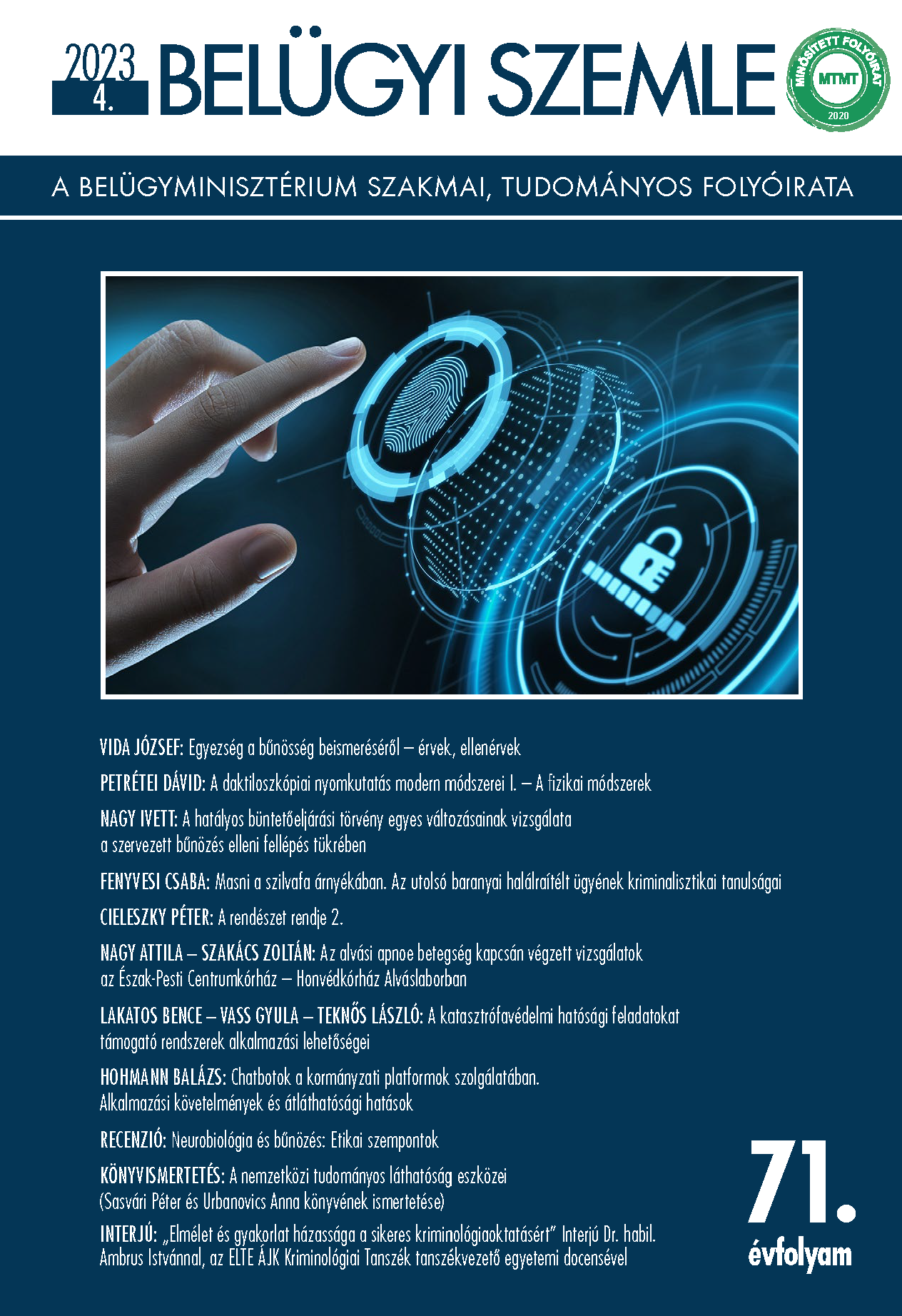Keywords
latent print development
dusting
cyanoacrylate
How to Cite
Abstract
Aim: The first half of the two-part study presents the physical methods of latent print developments, method classification, brief history, and future trends.
Methodology: The study synthesizes some of the most important technical handbooks and dozens of articles, published in the last decades. It also includes my own previously published research results.
Findings: The so-called physical methods of latent print development are still under ongoing research. Methods from the 19th century, like powdering, are still being developed. VMD has once been replaced by cyanoacrylate fuming in the late seventies, but in the last 1-2 years it is spreading again.
Value: In the Hungarian literature, such a comprehensive review has not been
published on this subject for a long time.
Downloads
Similar Articles
- Tamás Vörös, Krisztina Takács, Attila Szabó, Attila Krizsán, Applications of annealing in forensic glass examinations , Academic Journal of Internal Affairs: Vol. 71 No. 1 (2023)
- Emőke Noémi Baráth, Latent and manifest effects in law enforcement higher education , Academic Journal of Internal Affairs: Vol. 70 No. 9 (2022)
- Dávid Petrétei, Theoretical Issues of the Trace and Pattern Evidences in the 21th Century , Academic Journal of Internal Affairs: Vol. 70 No. 5 (2022)
- Dávid Petrétei, Modern Methods of Latent Print Development II – Chemical Enhancement Methods , Academic Journal of Internal Affairs: Vol. 71 No. 7 (2023)
- Tibor Ibolya, Forgotten criminalists: Béla Gábor, the first Hungarian expert on dactyloscopy , Academic Journal of Internal Affairs: Vol. 62 No. 3 (2014)
- István Zsolt Máté, Investigating attacks on IT-systems: the role of digital evidence , Academic Journal of Internal Affairs: Vol. 66 No. 7-8 (2018)
- Klaudia Lohner, Zsombor Hermann, József Haller, Traces of sexual motivation at the crime scene: from criminal psychology to forensics , Academic Journal of Internal Affairs: Vol. 69 No. 10 (2021)
- Erzsébet Molnár, Integrity in Organization to Prevent Criminal Liability – Integrity Theory in Criminal Prophylaxis Approach , Academic Journal of Internal Affairs: Vol. 69 No. 11 (2021)
- Dávid Petrétei, Print development from human skin , Academic Journal of Internal Affairs: Vol. 63 No. 11 (2015)
- Annamária Bodnár, Zsuzsanna Szabó-Nagy, The persistence and uniqueness of fingerprints , Academic Journal of Internal Affairs: Vol. 64 No. 7-8 (2016)
You may also start an advanced similarity search for this article.
Most read articles by the same author(s)
- Márton Lontai, Horolma Pamzsav, Dávid Petrétei, Artificial Intelligence in Forensic Sciences Revolution or Invasion? , Academic Journal of Internal Affairs: Vol. 72 No. 4 (2024)
- Dávid Petrétei, Criminalistics, police science, forensic sciences – reflections on the anniversary of the Hungarian Association of Police Science , Academic Journal of Internal Affairs: Vol. 72 No. 5 (2024)
- Márton Lontai, Horolma Pamjav, Dávid Petrétei, Artificial Intelligence in Forensic Sciences Revolution or Invasion? Part II , Academic Journal of Internal Affairs: Vol. 72 No. 8 (2024)
- Márton Lontai, Horolma Pamzsav, Dávid Petrétei, Artificial Intelligence in Forensic Sciences Revolution or Invasion? Part II , Academic Journal of Internal Affairs: Vol. 72 No. 8 (2024)
- Dávid Petrétei, Criminalistics, police science, forensic sciences – reflections on the anniversary of the Hungarian Association of Police Science , Academic Journal of Internal Affairs: Vol. 72 No. 5 (2024)
- Dávid Petrétei, The Future of the Criminalistics, the Criminalistics of the Future , Academic Journal of Internal Affairs: Vol. 62 No. 10 (2014)
- Dávid Petrétei, Theoretical Issues of Forensic Identification , Academic Journal of Internal Affairs: Vol. 68 No. 2 (2020)
- Dávid Petrétei, Print development from human skin , Academic Journal of Internal Affairs: Vol. 63 No. 11 (2015)
- Dávid Petrétei, Theoretical Issues of the Trace and Pattern Evidences in the 21th Century , Academic Journal of Internal Affairs: Vol. 70 No. 5 (2022)
- Dávid Petrétei, Blood pressure analysis as an innovative tool for site detection , Academic Journal of Internal Affairs: Vol. 65 No. 2 (2017)

